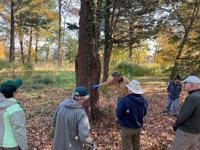LEWES, Del. — Restoration efforts at the Fourth Street Preserve advanced this weekend as members of the Delaware Master Naturalist Program began removing invasive plants from the 29-acre property. Volunteers targeted English ivy, a fast-spreading non-native species that threatens native trees and plants throughout the site.
The Fourth Street forested site, the first land ever deeded in Lewes in 1670, is now property of the City of Lewes, thanks to a campaign spearheaded by the Greater Lewes Foundation.
The removal of English ivy marks the beginning of a larger ecological restoration effort at the preserve. By clearing invasive growth, the task force hopes to make way for native vegetation, improving biodiversity and long-term sustainability.

Removing English Ivy is the first step in getting rid of invasive species in the new preserve.
“These actions may seem small, but they represent major progress toward the Preserve’s long-term vision—a thriving, accessible urban forest right in the heart of Lewes,” said Rodney Robinson. “We’re grateful for the Master Naturalists’ expertise and dedication, and for the community’s ongoing support as this important work continues.”
In addition to the plant removal, Robinson joined fellow task force members Jim Ford and Scott Wilkinson in marking the route for a future walking trail. Stakes now outline the southeastern section of the planned path, which will provide public access while minimizing environmental impact.
The public is encouraged to get involved in the restoration effort. The Fourth Street Preserve Task Force holds monthly meetings at Lewes City Hall on the second Wednesday of each month at 2 p.m.
For updates and volunteer opportunities, visit fourthstreetpreserve.org or follow the Open Space Alliance on Facebook.









